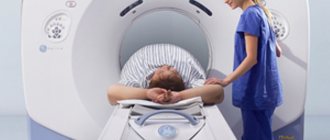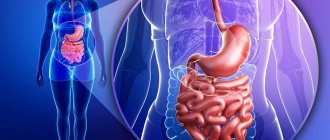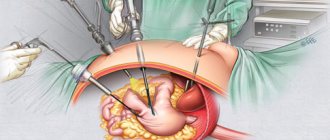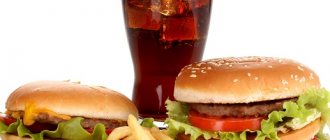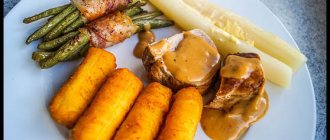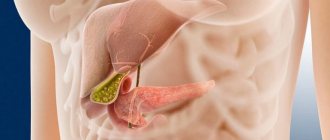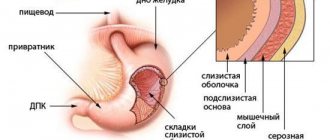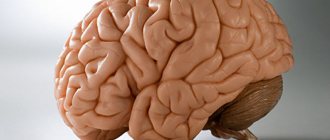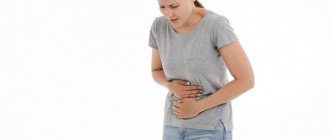Fibroesophagogastroduodenoscopy is the only informative research method that can provide information about the condition of the organs of the digestive system. The procedure is painless and, with proper preparation, is performed within no more than 5 minutes. It is carried out using an endoscope, where the diameter of the tube is about 1 centimeter. This safe diagnostic method is suitable even for children; the main thing is to get in the right mood and follow all the specialist’s recommendations.
What is FGDS?
Fibrogastrodudenoscopy (gastroscopy, fibrogastroscopy, esophagogastroscopy) is a widespread modern endoscopic method for instrumental examination of the condition of the mucous membrane of the esophagus, stomach, and duodenum.
The manipulation is carried out using a gastroscope (fiberscope, fibergastroscope, endoscope) equipped with a flexible probe with a video camera, which allows you to visualize the localization and extent of inflammation of the mucous membrane, pathological changes: ulcer, erosion, tumor, foreign body, polyp. During the procedure, if necessary, you can take a biopsy and deliver medicine to the lesion.
The medical manipulation received its name from the first letters of the words: fibro - optical fiber or probe, esophago, gastro and duodeno - the location of the pathological process: esophagus, stomach or duodenum, scopy - means to see. All together is a complete description of the procedure. The study is very unpleasant, unsafe, but tolerable and informative. It has no real analogues.
https://youtu.be/f0XHkA5QGXY
Indications
It must be emphasized that FGDS is prescribed strictly according to indications. Sometimes - in the absence of complaints from the patient. However, there are those who like preventive examination of the stomach using this method or who require a doctor to prescribe a study for any negative symptoms. This is fundamentally wrong and even dangerous. FGDS should only be performed by a very qualified doctor who knows the anatomy of the digestive tube well, since with any deviation from its natural course, complications are possible, even fatal, due to the risk of perforation of the organ wall. Therefore, it is unwise to do FGDS again. The doctor decides everything. Fibrogastroscopy is recommended for:
- abdominal pain of unknown etiology;
- discomfort in the esophagus;
- suspicion of a foreign object;
- prolonged, intractable heartburn;
- constant nausea for no apparent reason;
- uncontrollable vomiting;
- regurgitation after eating;
- dysphagia – inability to swallow;
- sudden, causeless weight loss;
- lack of appetite;
- anemia of unknown origin;
- pathologies of the liver, biliary system, pancreas;
- hereditary pathology such as stomach cancer or ulcers;
- preparation for complex abdominal interventions;
- medical examination;
- monitoring the effectiveness of treatment for diseases of the digestive tract;
- polyp removal;
- clinical follow-up after polypectomy.
Why is FGS prescribed?
The reason for planning this procedure may be an extensive list of symptoms. They are not necessarily all present, but each of them indicates certain problems in the gastrointestinal tract.
- Heartburn.
- Belching.
- Vomit.
- Loss of appetite.
- Sudden weight loss.
- Bloating.
- Pain in the gastrointestinal tract.
There is a possibility of emergency passage of FGS
- Bleeding in the gastrointestinal tract.
- Foreign body.
- Possible complications of chronic diseases of this plan.
Preparing for the study
Carrying out fibrogastroduodenoscopy requires special preparation. Moreover, the better the pre-preparation is carried out, the more accurate and informative the result of the manipulation will be. A few days before the procedure, you need to stop taking medications or agree with your doctor (lifelong use of medications). Injections, sprays or lozenges are usually allowed.
It is better if the FGDS study is preceded by a preparatory diet. A couple of days before the manipulation, spicy foods, alcohol, chocolate, citrus fruits, nuts, seeds, legumes, and raw vegetables should be excluded from the diet.
12 hours before , the last meal should be no later than six in the evening, subject to FGD in the morning. Carrying out the manipulation on an empty stomach is due to the fact that all digested food must have time to be evacuated from the stomach; moreover, the insertion of the probe should not provoke a gag reflex.
If the procedure is performed in the afternoon, you can have breakfast before 9 am. The fasting period can be extended for patients with problems in the digestive tract. Two hours before the procedure, you can drink mineral water.
A few hours before the test, you must stop smoking, since nicotine stimulates gastric secretion and stimulates vomiting. 5 minutes before the procedure, the doctor may prescribe Espumisan to prevent excess foaming.
Other non-invasive studies can be done on the day of FGDS. It is very good to examine the condition of the mucous membranes, if you have previously suffered from acute respiratory infections, ARVI, influenza, infections, herpes, seizures, cracks have been diagnosed - they need to be stopped.
Immediately before the test, you need to give the doctor your passport, compulsory medical insurance policy, referral for FGDS, and the results of previous tests. You need to have an individual towel with you, since you will need to remove drool and other body fluids.
Important Features
If a patient is recommended for an FGDS with a biopsy, you need to have an idea of the proper preparation for the procedure and the requirements for the regimen after leaving the endoscopy room.
The results of additional tests are not always made available immediately along with a description of the probe examination of the gastrointestinal tract cavity. A conclusion on the material sent to the laboratory can be received in a few days.
Indications
Gastroscopy with biopsy is prescribed primarily in three cases:
- Diagnosis of Helicobacter pylori infection.
- Assessment of the severity of peptic ulcer disease and the risk of malignancy (malignancy) of mucosal tissues.
- Suspicion of a neoplasm.
https://www.youtube.com/watch?v=KzGZIyeFdLc
What does a biopsy show during FGDS? This procedure allows you to find out the presence of infection, for which different methods are used:
- sowing on nutrient media;
- preparing a smear for microscopy;
- polymerase chain reaction (PCR);
- urease test with dye.
The method is also indicated for detecting changes characteristic of tumor foci and differential diagnosis of malignant tumors and polyps. To do this, a targeted biopsy is taken. At least 4-5 fragments are excised, which makes it possible to increase the information content of the test. Special sections are prepared from the resulting material, which are stained and examined under a microscope.
Contraindications
Taking a biopsy is not recommended if the patient:
- suffers from diseases in which blood clotting is reduced;
- is in serious condition (pathology of the heart, respiratory system, kidneys);
- has poor esophageal patency;
- is in a state of psychomotor agitation, panic;
- suffers an infectious disease in the acute stage or a chronic one - at the stage of resumption of symptoms;
- did not prepare properly for the FGDS procedure.
Obtaining biopsy samples is postponed if the patient has recently suffered heavy bleeding (not only associated with diseases of the gastrointestinal tract) or has unsatisfactory red blood counts (low hemoglobin, red blood cells).
Preparation rules
FGDS is carried out strictly on an empty stomach. The stomach must be empty, otherwise the study will be uninformative and will have to be repeated again. In case of an emergency procedure (bleeding, burn), rinsing is performed using a probe, but before the scheduled test you need to prepare:
- For 2 days, follow a diet - without stone fruits and vegetables, chocolate, seeds, baked goods, spicy foods, nuts.
- The evening before the test, eat a light dinner before 10 p.m.
- On the morning of the test, do not eat or drink anything, including pills, and do not smoke.
You need to prepare for gastroscopy of the stomach in advance. You need to take with you a direction, a towel, a sheet and the results of previous FGDS studies, if any. It is better to wear loose clothing that does not interfere with breathing, made of non-staining fabric - saliva or digestive juice may get on it. You should inform your doctor about any allergies to medications (as lidocaine or another drug is often used during the procedure to relieve throat discomfort). You need to arrive at the endoscopy room 10 minutes before your scheduled time.
Regimen after FGDS
The procedure usually does not have a significant impact on the patient’s well-being, but a number of rules should be followed:
- do not eat or drink anything for 30-60 minutes;
- do not overwork;
- stick to a diet without spicy foods, alcohol, stone fruits and vegetables, seeds and nuts.
During the day after the biopsy, you can only consume foods and drinks that are at room temperature or slightly cooled.
If anesthesia was used, you should refrain from driving a car or making important decisions that could affect your work process or everyday life for 24 hours. When using sedatives, it will be better if the patient is picked up from the clinic by a close friend or relative or by taxi (to avoid standing in stuffy public transport).
Progress of manipulation
Before the procedure, the doctor takes the patient’s written consent to perform it. Thus, the subject takes responsibility for possible flaws in the study, since he was warned about them in advance.
The oral cavity is treated with lidocaine (Falimint tablet under the tongue is an alternative). The patient takes a comfortable position on the left side: the cheek is pressed to the pillow, hands are on the chest (stomach). You can move your left hand over your stomach to your back, and your right hand to your stomach. After this, a special mouthpiece is placed in the mouth, which the patient clamps with his teeth. This is a concern for the safety of the gastroscope tube.
The doctor slowly inserts the endoscope probe into the mouth through the mouthpiece to the root of the tongue. The patient must take a deep breath and swallow saliva, at which time the fiberscope is placed in the esophagus. The doctor carefully moves the probe down the digestive tube, examining the walls of the esophagus, stomach and duodenum. All this time, the patient breathes deeply, which minimizes the urge to vomit. The person feels the advancement of the probe as itching. The procedure can take from 5 minutes to half an hour, depending on the severity of the pathological process. In some cases, a biopsy or removal of a small polyp or cauterization of the erosion is necessary. After all manipulations are completed, the fiberscope is slowly and carefully removed from the digestive tube.
After the procedure, you should not eat or drink for about an hour until the normal environment in the areas being examined is restored. If a biopsy has been taken, hot or cold food is limited until the evening (warm only), and for a day or two it is recommended to exclude fatty and coarse foods from consumption.
Since anesthetics are used during FGDS studies, you cannot drive a car immediately after the procedure: concentration of attention is reduced.
How do they do it?
Traditionally, the procedure is carried out in the morning. First, the patient goes to the specialist’s office to sign an agreement in which he consents to the procedure.
It is important to understand that FGDS can be completed completely painlessly and without sedation. The doctor will not intentionally hurt you. As long as you are relaxed and maintain a calm breathing rhythm, the endoscope will advance without causing pain or discomfort.
The procedure is done in a certain way, depending on the type of research. So, for standard manipulation, the patient is asked to lie on the couch (on his left side) and the gastroenterologist irrigates the patient’s nasopharynx with an anesthetic. A couple of minutes after the anesthesia begins to take effect, the patient should grab the mouthpiece with his teeth, which will help avoid injury to the teeth and mucous membranes of the lips.
Then the most important stage begins - inserting the tube through the pharynx into the esophagus. The process takes a few seconds and as the probe passes through the esophagus, the person experiences the urge to vomit, which must be overcome. To make it easier to endure the insertion of the endoscope, breathe calmly, measuredly, without strong swallowing movements. Try concentrating on your breathing and counting your exhalations and inhalations. Afterwards, it is important to relax and the doctor will begin to examine the internal organs.
How long you relax and let the doctor do his job will determine how long the examination will take. On average, the whole process takes 5-10 minutes.
Some time after the FGDS, the patient is given a conclusion with the diagnosis (or to his attending physician).
Transnasal gastroscopy does not differ from the standard procedure in any way, except for the location of the probe insertion - through the nasopharynx.
First, the patient also lies on his left side, then his nasopharynx is treated with an anesthetic, and after a few minutes a probe is inserted through the nostrils.
In this case, there is no discomfort or vomiting. After the end of the manipulation, the patient can receive a conclusion.
FGDS with the help of sedatives is the simplest of the presented options using an endoscope. The positive side of this diagnostic method is the absence of anesthesia as such, because drug-induced sleep is easily tolerated: after the procedure there is no lethargy or lethargy, and after just 40 minutes you can leave the clinic. However, it is advisable not to drive a car during the day.
Possible complications
Despite the seriousness of possible complications, they are reduced to almost zero (statistical data). But, nevertheless, possible. These are: damage to the wall of the organ being examined, up to perforation, uncontrolled bleeding, secondary infection with the development of sepsis in extreme cases.
Delayed complications are possible, so if signs of inflammation or secondary infection appear: fever, chills, abdominal pain, bloody vomiting, black stools, you should seek help from a doctor.
Data decryption
FGDS is carried out in order to assess the functional viability of the upper digestive tract. Therefore, in the process of deciphering the obtained data, attention is paid, first of all, to the condition of the mucous membrane and the lumen of the digestive tube. Define:
- patency of the organs being studied;
- the presence of stenosis, strictures, narrowings, scars that deform the lumen;
- tightness of the cardiac sphincter (between the stomach and esophagus);
- defects of the mucous membrane of the esophagus, stomach, duodenum: inflammation, ulcers, erosion, atrophy, hypertrophy, metaplasia, atypia;
- the presence of reflux: reverse reflux of food - esophagogastric and duodenogastric;
- diaphragmatic hernia;
- diverticulosis;
- tumors of various origins: polyps, papillomas, cancer;
- stage of gastritis and other digestive pathologies.
Such diagnostic capabilities of FGDS make the procedure indispensable in many branches of medicine: gastroenterology, surgery, oncology, and in the treatment of the digestive organs. Therefore, despite the discomfort from the procedure, it cannot be neglected; it is better to tune in morally and remove the question that has arisen about the state of the gastrointestinal tract forever.
Endoscopic picture
The mucous membrane of the digestive organs of a small patient should have a light pink tint, a shiny and smooth surface. In addition, the vascular network is clearly visible along the entire length of the esophagus. During an endoscopic examination of infants, it is clear that there are practically no folds in the stomach, and its walls have the same structure in all sections. The jagged border between organs appears smoother and more curved.
During the examination, when air is supplied, the internal epithelium of the organs is easily straightened. Using an endoscope, the doctor can detect areas with pathological abnormalities in the tissues of the gastrointestinal tract. This equipment allows you to identify defects and disorders in all parts of the digestive system.
What does the procedure reveal?
Fibrogastroduodenoscopy allows you to correctly make a diagnosis in a large number of controversial, unclear cases. With its help you can detect:
- latent ulcer of the stomach or duodenum, often at the stage of debut of the pathology, which saves the patient from surgical intervention;
- polyps of different localization and origin;
- malignant tumor of the stomach;
- esophageal varices are a consequence of liver cirrhosis;
- esophageal or cardiac reflux;
- inflammation of the esophagus;
- narrowing of the duodenum;
- preservation or disruption of the evacuation of food from the stomach, that is, a functional imbalance in the motility of the upper parts of the digestive system.
Contraindications
In some cases, it is too risky to perform such an inspection of the problem area. Absolute ban:
- strokes and heart attacks;
- blood clotting problem;
- exacerbation of bronchial asthma;
- severe curvature of the spine;
- possible displacement of the esophagus;
- enlarged thyroid gland;
- refusal of the patient or representative.
Relative prohibition: inflammation in the throat; uncontrolled behavior; enlarged lymph nodes in the neck; hypertension at the third stage; angina pectoris. If in the first case the inspection cannot be carried out categorically, in the second it can be carried out if the potential benefit is greater than the potential harm.
Is there an alternative to FGDS?
There is no alternative to fibrogastroduodenoscopy. Of course, we must not forget about the availability of ultrasound diagnostics and X-ray examination methods. But all of them provide only part of the information about the state of the organs of the upper part of the digestive tube: the stomach, esophagus and duodenum.
FGDS is the most informative, safe and reliable method of examining a patient with gastrointestinal problems. Emphasis must be placed on proper general and psychological preparation of the patient. And one more thing: it is advisable to do the test for the first time in a specialized clinic, with a qualified and experienced specialist. Then repeated procedures, if necessary, will not raise any questions.
Alternative methods
If there are limitations to gastroscopy, then other examination methods are used. In such cases, doctors prescribe alternative options for examining the mucous membrane of the digestive tract to their patients. The most popular and safest for a baby is capsule endoscopy. The essence of the diagnosis is that children need to swallow a special small optical device equipped with a camera.
The capsule moves through the digestive tract, simultaneously taking pictures of the mucous membrane. Using a computer program, photographs are combined into a common video sequence. While viewing the resulting film, the doctor analyzes and evaluates the images. Of course, this method also has its disadvantages. The main disadvantages include:
- it is difficult for a child to swallow the device;
- no manual camera control;
- Children under 1 year of age should not be examined.
